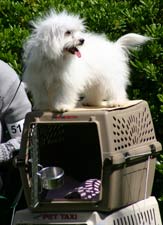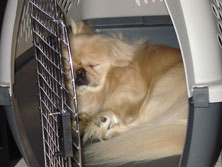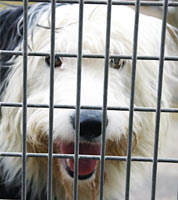Crate Training a Puppy Will be an Asset for Years to Come
Crate training a puppy will be an asset for years to come, but introducing this step properly is the key to your success with dog crate training.
As with most puppy and dog training, there are many controversies about crate training out there, but this is one of the most important steps in your dog’s life. You can use the benefits of crate training a puppy for everything, from Puppy Potty Training and Puppy Obedience Training to more complicated things like destructive behaviors or separation anxiety.
The truth is that even wild dogs and wolves naturally spend a lot of time in their dens. If you observe your dog, on an overnight trip, most of the time he will spend just resting or in a very shallow sleep simply because he doesn’t feel comfortable away from his own ‘den’. By crate training a puppy you are actually accommodating your dog’s natural instincts.
Step One: Choose the type of dog crate
To start you will first need to choose the type of dog crate that you want and need. There are a few different types in general, and they can vary in price and quality.
Aluminum/metal dog crates: Many of these are made to last throughout the dog’s life and are normally of an open type of crate. The sides are made of aluminum bars or squared wire. Sometimes you may find it necessary to cover this type of crate, in order to allow for a calmer environment for your dog, especially if he is a young or a nervous dog. Combination plastic/metal dog crates: Lighter in their construction and often easier to handle; these are mostly of a closed type as all sides are closed in except the front doors, or perhaps the front and back doors. Of course there are air vent holes on the sides of these crates.
These crates in general, produce a calmer scenario for dogs as they are closed in and more contained. You may also find that it is easier to control your pet’s hair from spreading all over the house, especially with short-haired breeds. These plastic crates are the crates most often used for traveling as well.
Nevertheless, both types of dog crates (metal or plastic) are usually made to be collapsible and convenient to handle, maintain and transport, so the decision of which one is a better fit for crate training a puppy, is really up to you, your dog and your specific situation.
Step Two: Choose the dog crate size
Now that you have decided on a type of dog crate, it is time to choose the right size. The crate should be just big enough for the dog to stand up, turn around and lay down in. If you are buying a crate with the intention of using it throughout the life of your dog, it may seem too big right now while you are crate training a puppy. This can be adjusted by putting a cardboard box inside of it or some other material so that you can divide and limit the space inside.
TIP: If the dog crate is too big, your puppy will probably end up using one of the corners as his littering space.
Line the crate with a blanket or flooring that is comfortable but that your puppy can’t easily chew through. This is very important. If he destroys his first bed, he will likely try to destroy anything else that you later place inside.
If using an open type crate, there should be a rubber mat under the crate as well, this will eliminate noise when your dog is moving around and to prevent the crate itself from moving or sliding. This will also help prevent spilling on the floor if your puppy relieves himself or if you eventually keep water in the crate and it is accidentally spilled over.
TIP: A good habit at the beginning of crate training a puppy is to place a small item of clothing from each family member inside the crate, this will help your puppy to relax faster, and accept the crate as a positive experience.
Step Three: Choose the right place for the dog crate

You also need to choose a suitable place for the crate. You do not want your puppy to be confused or left searching; remember that the crate should be a pleasant, comfortable space for him. Many dog owners, when they start crate training a puppy, like to keep the crate somewhere close to them, and later they move it into a more permanent place.
Step Four: Introducing your puppy to the crate
Start slowly; every tool that you introduce into your dog’s life needs to be introduced properly, and when crate training a puppy, this step is crucial.
First, place a few treats inside the crate and let your puppy go in to eat them and then walk out, do this for about a half an hour or so. Then, while the puppy is inside but not watching you, close the door, just for a few seconds, then open it and let him out. It is important to stay calm when letting him out; you do not want to build excitement in your puppy when he is closed in the crate even if it is only for a few seconds while you are opening the door.
Gradually start increasing the time that you keep the door closed, but do not overdo it. Always take your time while crate training a puppy. Remember, this should be his safe area. Every time your puppy goes inside and comes outside of the crate, it has to be in a positive way. You do not want this experience to be anything but a positive one for your puppy.
Step Five: Leaving your puppy in the crate
Once your puppy is comfortable in the crate with the door closed, try leaving the room for a moment. When you come back, open the door, again…no excitement! You can later increase the amount of time that you are away.
Remember to never be longer than an hour at this stage. Depending on your puppy’s age, he shouldn’t stay closed in for a longer time than he can go without the need to relieve himself. This is usually a few hours at most, if he isn't sleeping. As your dog grows, you can increase the time that he is in the crate but it still shouldn’t be longer than 8 hours even for a grown up dog.
If your puppy starts crying or whimpering, DO NOT run over to him in a panic, cooing to him and letting him out of the crate immediately. This will just encourage him to practice this behavior whenever he wants attention. Instead, wait until he calms down and then let him out.

If you are not sure if he is perhaps crying because he may need to go potty, you can take him outside, but remember, no playing, no excitement, and no running around.
Allow him 15-20 minutes to do his business and if he still hasn’t done so, put him back into the crate for about 15 minutes more and then repeat the process. Only after he has done his potty outside, can you praise your puppy and allow playing time before he goes back to the crate.
To avoid the possible situation when you are not sure if your puppy needs to go potty or if he just wants attention, start your puppy crate training after he has gone potty and had a short play session. This way you will not encourage your dog’s whimpering by responding to it. The more often that you show up or acknowledge your dog when he cries, more he will cry.
This can also lead to unwanted behaviors that will make your dog more nervous and unsure about the whole procedure. Normally, the whimpering does not last long, but even if it takes longer than you expected, remember, paying any attention to your puppy at that time will only prolong and increase this behavior.
A potty accident may happen at any time in the crate, especially with a puppy. It is not a big deal. Your dog hasn’t done it on purpose. Remember, this is just part of the learning phase.
TIP: In case this does happen, make sure that you wash everything using non-toxic products (especially for puppies because they are mouthing everything at this stage of their life) and avoid using any ammonia-based cleaning products as they will only increase the smell of urine and may actually encourage your puppy to do it again.
A Place to Call Home
As mentioned, crate training a puppy is one of the best training steps that you can do for your dog. It really isn’t as difficult a step as some may think, and it will benefit your dog, his whole life. You are not just crate training him; you are providing him with his very own den.
To learn more about Puppy Training and for more Puppy Training Tips, follow the links to these pages below:
Puppy Development & Socialization
Return from Crate Training a Puppy to Puppy Training
Return from Crate Training a Puppy to Training Your Dog and You

